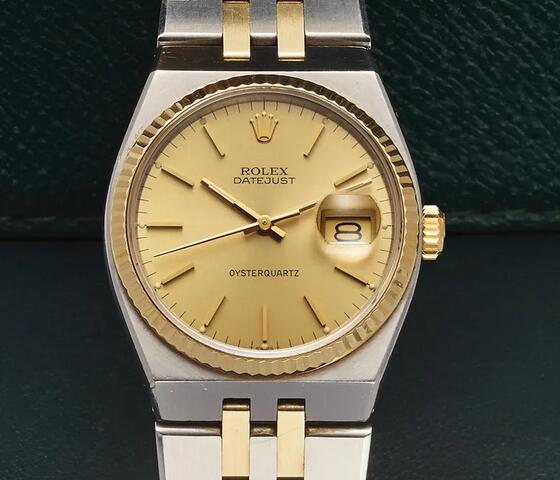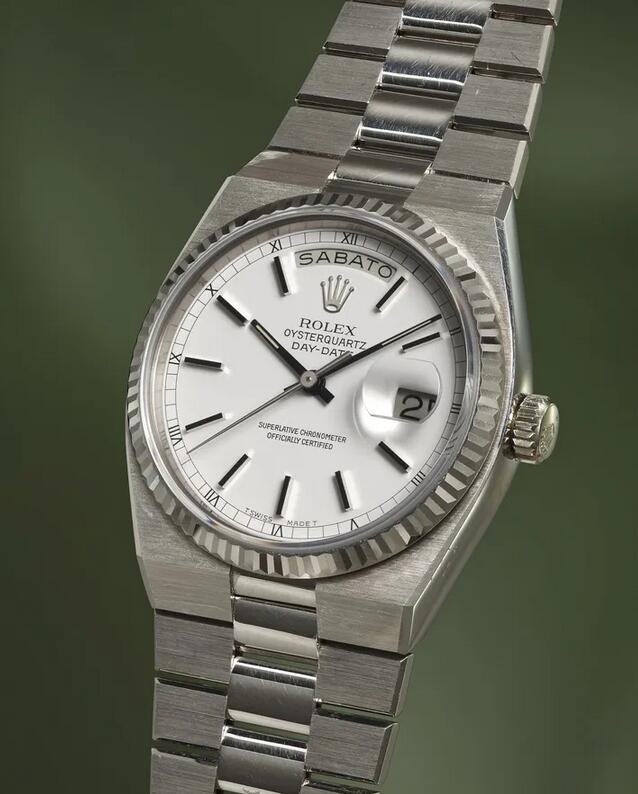If Rolex is the ultimate symbol of prestige among watches, at the other end of the spectrum would be cheap, battery-powered quartz AAA Rolex replica watches. At least, that’s a perception common among many lay consumers — and even sophisticated, experienced collectors. Though not without foundation, this assertion is too simplistic: Not only can quartz watches be every bit as refined as mechanical timepieces, but even top UK Rolex fake watches once made their very own: the Oysterquartz.

High quality replica Rolex watches today exclusively use traditional mechanics, deriving power from a an unwinding spring rather than from batteries. Quartz watch movements, on the other hand, are battery-powered, and are found in the majority of inexpensive watches out there. You can often spot the difference because a quartz watch’s seconds hand will tick every second, while a mechanical watch’s will sweep continuously (usually). Quartz has come to have a low-end image, and the idea of quartz perfect Rolex copy watches might seem contradictory to some.
Quartz not only gets a bad rap because of the multituds of inexpensive Rolex replica watches for sale it’s used in, but among watch enthusiasts it’s also a little resented because of the overall effect it had on the entire watch industry after the technology’s introduction to the market 1969. The “Quartz Crisis” killed many historic watchmakers who couldn’t keep up, and many illustrious brands hopped on the quartz bandwagon. But does this mean that those companies were suddenly making the type of low-quality, mass-produced fake Rolex watches online site that quartz is today often associated with? Far from it.
Rolex was one of them. At first, Rolex was among a group of 20 Swiss brands (the “CEH”) formed in 1962 to develop a quartz wristwatch movement. They released the Beta 21 in 1970 — losing the race to Seiko’s 1969 Quartz Astron — using it to power the first wholesale super clone Rolex quartz watches, the reference 5100 Rolex Quartz. Those early quartz movements, however, were only the first generation of such calibers and left a lot of room for improvement (think: short battery life, thick… square!), and Rolex eventually left the consortium to develop its own movement in 1972.
For brands that were wholly invested in traditional mechanical watchmaking, the leap to develop and produce a battery-powered quartz movement was no insignificant undertaking. It took the brand five years before its Oysterquartz was ready for market in 1977, and this then-futuristic-seeming tech called for a new look to distinguish it from traditional replica Rolex watches store.

The Oysterquartz didn’t simply replace mechanical movements in all existing best quality fake Rolex watches, but rather it formed a collection of its own. That’s why “Oysterquartz” refers not just to the quartz movement but the watches themselves. While the movement was still being developed, the brand had already settled on a new case style that would house it — and they even produced some mechanical Swiss made Rolex replica watches (references 1530 and 1630) in this form to float the look. The Oysterquartz took established Rolex elements and integrated them into a case design that would have been seen as very modern at the time.
It was the 1970s, and Gerald Genta’s Royal Oak and Nautilus were introducing a new category of luxury sport watches to the market. The angular design of the Oysterquartz watch cases with their integrated bracelets fit right in with those Genta designs, even though the bezels and dials stayed true to luxury fake Rolex’s existing Datejust and Day-Date watches. It’s as if you can see multiple watch industry trends of the 1970s all converging at once in the Oysterquartz.
There were variations on these watches over the Oysterquartz’s 24-year run with different bezel styles, dial elements like Roman numerals, as well as case materials and bracelet options — but they were more or less consistent with the perfect UK replica Rolex Datejust and Day-Date lines. The cases have a cool look (IMO) and helped distinguish the collection, but it was the tech inside that was the big deal. How was the Oysterquartz movement different or better than other contemporary quartz examples?
They operated at a frequency around four times that of the Seiko’s first Astron, were certified for accuracy by Swiss COSC as chronometers, and incorporated thermoregulating features — and the tech continued to evolve and improve in subsequent generations. Notably, and in stark contrast to the image quartz China Rolex fake watches tend to evoke today, these Oysterquartz movements were even more highly finished than many of their mechanical counterparts. No green circuit boards here: rather, they featured beautifully Geneva-striped metal.
These Rolex Oysterquartz movements were clearly produced with great care and attention to detail — and the Rolex replica watches paypal weren’t inexpensive. They were the cutting-edge, high-end option of their time, whereas mechanical clockwork was seen as an outgoing anachronism. (The script was later flipped when highly accurate and robust quartz movements became extremely cheap to mass-produce, and mechanical watches were rebranded as luxury items.)
Rolex stopped producing its Oysterquartz around 2001, and it’s believed that the brand made around 25,000 of them over their 24-year lifespan. Today, the perfect quality fake Rolex Oysterquartz watches are largely overlooked, but present a side of Rolex that many people have forgotten. They also make a strong case for the argument that quartz watches can be high-quality and interesting luxury items. Even though Rolex no longer makes them, quartz watches just might be worth a second look.